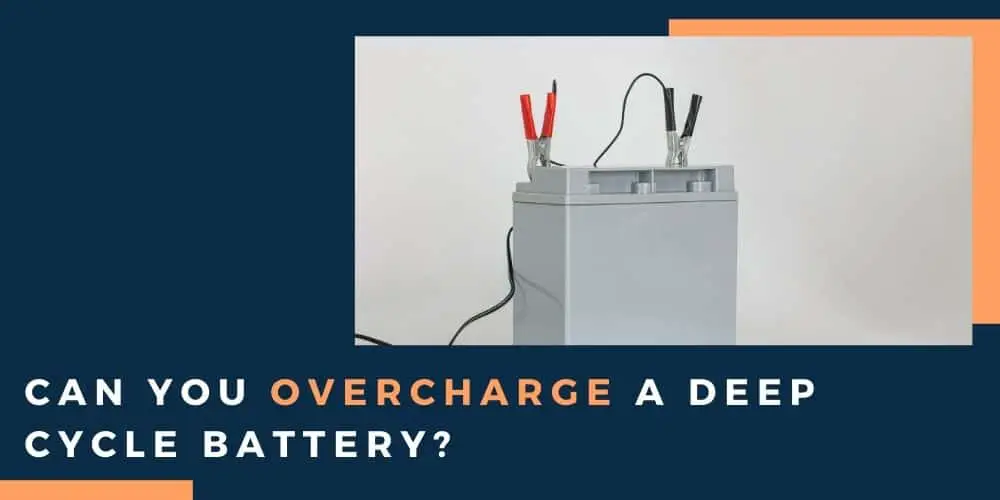Smart chargers for your deep cycle battery are a good idea. The main reason for this is that they have voltage regulators which can determine when your battery has reached a proper level of charge and then, consequently, shut themselves off.
This leads to a question that we get quite often from our readers which will be the subject of our article today.
Can you overcharge a deep cycle battery?
If you are not using a smart charger with a voltage regulator then you must monitor your charge cycle closely because overcharging is a very real possibility. Not only can you overcharge a deep cycle battery it could be dangerous and damage the battery itself.
We’ll discuss what happens when you overcharge as well as what happens if you don’t charge that battery enough. After that, we’ll let you know why it is important to also check your fluids regularly if you want to keep your battery in good shape so that it will last for the long-haul.
Let’s start with what happens when you overcharge.
Contents
What happens when you overcharge a deep cycle battery?
When you overcharge your battery there are 3 primary issues which can occur. Those issues are as follows:
- Increased fluid consumption – Overcharging can diminish the water which suspends the electrolytes that your battery relies on. If the charge cycle is left unattended overnight it can even dry out the battery, voiding your warranty and possibly destroying the battery.
- Temperature damage – Once the current is full, if the charge continues for a prolonged period the internal temperature of the battery can actually start to damage it.
- Corrosion – The positive battery plates inside your deep cycle battery can become corroded from overcharging.
What happens if you don’t charge it enough?
Undercharging your battery is also a bad idea. By undercharging, we mean that you either don’t have a regular schedule for charging your battery or if you are only charging it for small charging cycles that are of insufficient time to bring the battery to full charge.
The reason why this can be bad is called Sulfation. Sulfation has to do with small sulfate crystals that form inside the battery and tend to remain quite innocuous if the battery is regularly charged.
When it is not, however, then these crystals can become denser and ‘gum up’ the negative charge plate. This leads to less efficient charge cycles and reduces your overall battery life.
Checking the fluids on your deep cycle battery
Aside from the portable charger doing its work, deep cycle batteries come with an extra step in their maintenance and this is, of course, checking their fluid levels.
Every now again you’ll need to top off your deep cycle battery with a little distilled water but you will also want to check the acidity with your Hydrometer to see if it is as the levels detailed in your manual.
This is because those distinctive ‘water holes’ you see in some deep cycle batteries are cells, which contain distilled water and electrolytes that your battery uses to function. They do need refilling on occasion but you have to be careful not to under or overfill them or the following may occur:
- Underfilling – Can cause the plates to dry out and damage the electrolyte balance of the cells.
- Overfilling – Too much water dilutes your electrolyte solution and in turn leads to lower performance from the battery.
So, how much is the proper amount? As a general rule, you want the fluid level to be just under the bottom of the vent or ½ inch above the plates. Now, you might have heard about a shortcut of lowering the charge voltage to 13 volts or lower as a ‘hack’ to require you to check the water less.
This DOES work but it has a big, nasty caveat. This practice can cause the electrolytes to separate from the battery acid and clump up on the plates below.
This is called ‘stratification’ and it can lead to sulfation in the battery as well, so it is not so much a ‘hack’ as it is a surefire way to slowly damage your battery.
Chargers & Accessories
| Image | Title | Price | Buy |
|---|---|---|---|
 | EZRED SP101 Battery Hydrometer | Latest Price on Amazon | |
 | LEICESTERCN Battery Tester | Latest Price on Amazon | |
 | NOCO GENIUS5, 5-Amp Fully-Automatic Smart Charger | Latest Price on Amazon |
Consider a smart charger to get the most out of your battery
Today we have addressed the question of whether or not it is possible to overcharge a battery and as you can see, it is not only possible but easy to do if you do not currently have a smart charger.
We’ll close with a recommendation that you consider investing in one because they will really help you to get the most out of your battery.
Smart chargers use a 3-stage charging process that can charge your battery quickly, efficiently, and without your supervision. It negates the possibility of an overcharge completely and as a bonus, your battery will last longer.
In the meantime, until you’ve got a smart charger, just keep those fluids at the proper levels and check your battery once an hour during charge cycles for best results and to avoid overcharging.






